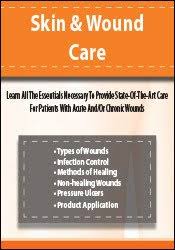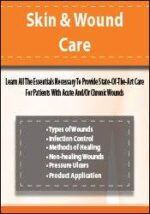Available for Pre-Order. This product will be available within a few days.
Ann Kahl Taylor – Skin & Wound Care
Yikes! Maggots!
Leg & foot ulcers: Get them healing now
Wound measurements & cultures: Are you doing them right?
The latest wound dressings and products
Proven wound prevention tricks
Infection control strategies
Tips for patient adherence
Wound care expert, Ann Kahl Taylor, MS, RN, CWOCN, has been in your shoes. She struggled to manage a busy schedule and heavy patient load, and still keep up with all of the changes in wound care protocols, products and treatment options. Then she did something about it – she started teaching nurses, physical therapists, occupational therapists and physician assistants. And in one short day, she can teach you assessment and treatment techniques you didn’t know, and bring your skin and wound management skills to a new level!
Learn the latest intervention strategies for successful skin and wound care, including
cleansing, debridement and dressing application
infection control challenges and solutions
the best methods for documenting skin and wound care
the latest products for cleansing, moisturizing, sealing, protecting
dressing options and selection rationale
Ann’s evidence-based research and vast clinical experience, coupled with photographic examples and her consultative approach, allow her to deliver this material in a style conducive to learning and real world application. Register today for this wonderful learning opportunity!
OUTLINE
Wound and Skin Care Challenges
Traumatic Lesions
Skin Tears
Surgical
Pressure Ulcers
Controversies & Trends in Staging
Deep Tissue Injury
The Specifics on Heel Ulcers
Pressure Management
Infection
Candida
Colonization
Obtaining Wound Cultures the Right
Way
Dehisced Surgical Wounds
Necrotizing Soft tissue Infections
Grafting
Cellulitis
Chronic Sub-Clinical Infections
Osteomyelitis
Circulatory Disorders
Vascular Lesions
Arterial Insufficiency
Venous Stasis disease
Special Population Considerations
Diabetic
Bariatric
Neonatal
Advanced Age
Achieving Successful Wound Healing
Overcoming Common Impediments
Nutritional Challenges
Unintentional Weight Loss
Malnutrition
Protein-Energy Malnutrition (PEM)
Tissue Perfusion & Oxygenation
Necrosis
Wound Assessment
Location
Age
Measurement
Base
Odor
Drainage
Wound Edge
Pain
Wound Staging
In-depth Description of
Stage 1, 2, 3, 4
Suspected Deep Tissue Injury (SDTI)
Unstageable Wounds
Case Studies
Topical therapy
Dressing Selection & Use
Antimicrobials
Pain Management
Cost/Reimbursement Considerations
Debridement
Treatment Choices
Pulsed Lavage
Maggot Therapy
Moist Wound Healing
Exudate Management
The Latest in Dressing Options
Avoiding Maceration
Negative Pressure Wound therapy
Active Therapy: Vacuum-Assisted
Wound Closure
Usage Tips
Issues and Complications
Adjunctive Wound Therapies
Ultrasound
Estim
Discharge Planning/Plan of Care
Would you like to receive Ann Kahl Taylor – Skin & Wound Care ?
Strategies for Continence Care
Skin Cleansing Techniques
Moisture Management
Treatment Strategies
Pharmacological
Fecal Containment Devices: Beyond
Traditional Rectal Tubes
Surgical
Barrier Ointments & Creams
Tips, Tricks & Techniques for Ostomy & Fistula Care
Choosing the Right Appliance & Accessories
Pouch Application Techniques
Products for Gaps/Defects
Crusting: Treatment of Peri-Stomal Skin Damage
Beyond Treatment: Safeguarding Your License & Practice
Reimbursement
Documentation & Coding Strategies
National Treatment Guidelines
OBJECTIVES
Explain the comprehensive plan of care to promote optimal wound healing.
Identify characteristics of vascular, neuropathic and pressure ulcers, including deep tissue injury.
State several new interventions useful to support successful wound healing.
Differentiate between urostomy, ileostomy and colostomy.
List effective strategies and techniques for simple and complicated ostomies.
Identify appropriate interventions for urinary and fecal incontinence.
Implement tools to assist with assessment and management of patients with wounds, ostomies and incontinence.








